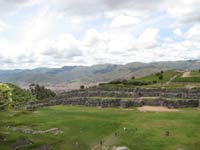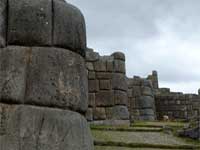 |
 |
 |
 |
| The hotel was on the very narrow street above, and looked out over the city. A spiral stair wound up inside the building. | |||
After breakfast we took the express bus (Tour Peru) from Puno to Cusco, and got to Cusco around 3pm. We stayed at the Encantada Casa Hotel, a very nice hotel in the San Blas district, within walking distance of the Plaza de Armas and the other sights of Cusco. Both our room and the roof terrace had a fantastic view across the city. There was time to take a look around Cusco that day
Friendly service, free internet access in lobby, interesting breakfast of buffet, fruit and eggs cooked to order. We left luggage when we went to Machu Picchu, and it was sitting in our room when we got back 4 days later. You want to ask for one of the front rooms with a view. Certainly I would recommend the hotel, and would stay there again myself
Click on the thumbnails below to get larger photos
 |
 |
 |
 |
| The hotel was on the very narrow street above, and looked out over the city. A spiral stair wound up inside the building. | |||
Cusco often spelled Cuzco is at an altitude of 3,400 m. Until the late 18th century Cuzco was the most populated city on the continent, even more than Lima. But because of the revolution of Túpac Amaru in 1780, the white population migrated to Arequipa, considered as a safer place if there was another uprising. Today Cusco has a population of around 400,000 which was triple the figure of 20 years ago.
Cusco was the historic capital of the Inca Empire and was declared a World Heritage Site in 1983 by UNESCO. About 1.5 million tourists come here every year.
The indigenous Killke people built the walled complex of Sacsayhuamán about 1100 AD. Cusco was the capital of the Inca Empire (13th century-1532). It was captured by the generals of Atahualpa in April 1532 in the Battle of Quipaipan. Nineteen months later, Spanish explorers invaded the city. The first Spaniards arrived on 15 November 1533.The buildings constructed after the Hispanic invasion have a mixture of Spanish influence with Inca indigenous architecture, including the Santa Clara and San Blas neighbourhoods. The Spanish destroyed many Inca buildings, temples and palaces. They used the remaining walls as bases for the construction of a new city. The Spanish colonists constructed many churches and convents, as well as a cathedral, university and Archbishopric. The Spanish buildings were based on the massive stone walls built by the Inca.
A major earthquake on 21 May 1950 caused severe damage in Cusco. The Dominican Priory and Church of Santo Domingo were among the colonial era buildings affected. Restoration work at the Santo Domingo complex was conducted in such a way as to expose the Inca masonry formerly obscured by the super-structure without compromising the integrity of the colonial heritage.
You will not be short of things to do in Cusco, and it is a pleasant city just to wander and admire the architecture. Sights of importance today are
Click on the thumbnails below to get larger photos
 |
 |
 |
 |
| Along the alto plano to Cusco. | San Blas the district we stayed in | Cathedral of Santo Domingo, | The Church of La Compañia |
 |
 |
 |
 |
| Convent of Santo Domingo | Calle Hatun Rumiyuq | Plaza San Francisco | |
 |
 |
 |
 |
| Sacsayhuamán | Sacsayhuamán | Convent of la Merced | Convent of la Merced |
 |
 |
 |
 |
| Convent of la Merced | Art Exhibition at la Merced | Art Exhibition at la Merced | Centre of Cusco |
From Cusco it was on to the Sacred Valley, Ollantaytambo and Machu Picchu . We then had another couple of nights in Cusco before catching the early morning flight to Lima, and on the same day to Easter Island